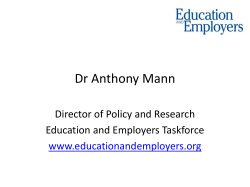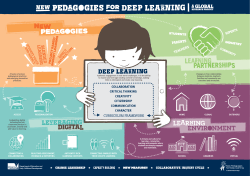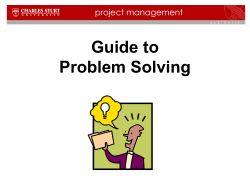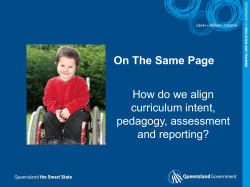
APPENDIX 2 - Creating Pathways to Success – Final
APPENDIX 2 - Creating Pathways to Success – Final Report for District School Boards Due: September 18, 2015 PLEASE SUBMIT TO SSL18.StrategicPolicy@ontario.ca Board Name: ___________________________________________________________________ Contact Name: ____________________________________________________________________________________________ Part A: Brief Description of How Funding was Used (See Schedule AH) In approximately 200 words, outline how the funding was used to plan for implementation of Creating Pathways to Success. Part B: Using the template below, indicate with a checkmark in the box provided where your board is in planning for implementation of Creating Pathways to Success, specifically related to Laying the Groundwork and Developing the Program (Chapter 6: Program Development, Implementation and Evaluation). Examples are provided as a guide only when considering where schools within your board may be on the continuum. Also, briefly explain your ‘next steps’ in the final column. Laying the Groundwork Beginning Developing Early Implementation Establish an Education and Career/Life Planning Program Advisory Committee. Committee must include: school administrators, teachers, students, parents, and members of the broader community e.g. some schools within board have committees which regularly meet e.g. many schools within board have committees which regularly meet e.g. all schools within board have committees which regularly meet Develop strategies to encourage broad parent and student engagement in the development of the program e.g. a limited number of strategies have been developed for implementation which encourage parent and support student engagement e.g. some strategies have been developed for implementation which encourage parent and support student engagement e.g. many strategies have been developed for implementation which encourage parent and support student engagement e.g. some schools have completed an assessment of student interests, strengths, needs, and aspirations e.g. many schools have completed an assessment of student interests, strengths, needs, and aspirations e.g. all schools have done an assessment of student interests, strengths, needs, and aspirations Consider the prevalence or distribution of particular student interests, strengths, needs, and aspirations, as they relate to education and career/life planning, among the students in the board’s schools Next Steps: What? Who? When? 1 Laying the Groundwork Beginning Developing Early Implementation e.g. some schools have provided professional learning to ensure all educators are familiar with the education and career/life planning policy e.g. many schools have provided professional learning to ensure all educators are familiar with the education and career/life planning policy e.g. all schools have provided professional learning to ensure all educators are familiar with the education and career/life planning policy Provide professional learning focused on the inquiry-based program framework and on strategies for embedding education and career/life planning in curricular and extracurricular programs, school-wide activities, and students in the community e.g. some schools have provided professional learning on the inquirybased process and embedding education and career/life planning to stakeholders e.g. many schools have provided professional learning on the inquirybased process and embedding education and career/life planning to stakeholders e.g. all schools have provided professional learning on the inquiry-based process and embedding education and career/life planning to stakeholders Developing the Program Assess how effectively the school’s existing career development program addresses students’ interests, needs, abilities, and aspirations and identify areas where improvement is needed Beginning Developing Early Implementation e.g. some schools have completed a gap analysis and identified areas of improvement e.g. many schools have completed a gap analysis and identified areas of improvement e.g. all schools have completed a gap analysis and identified areas of improvement e.g. some schools have identified priorities and included these in SIP e.g. many schools have identified priorities and included these in SIP e.g. all schools have identified priorities and included these in SIP e.g. some schools have reviewed school programs and identified next steps e.g. many schools have reviewed school programs and identified next steps e.g. all schools have reviewed school programs and identified next steps Ensure that all educators in the school are familiar with the education and career/life planning program policy Establish priorities for program development based on the assessment of the current program, and include these in school improvement planning (SIP) Review the school’s curricular and extracurricular programs to identify active use of learning opportunities related to education and career/life planning, and determine what needs to be done to make the education and career/life planning program comprehensive and embedded in the life of the school Next Steps: What? Who? When? Next Steps: What? Who? When? 2 Developing the Program Beginning Developing Early Implementation Create or reinforce structures and processes that support cross-panel collaboration related to education and career/life planning e.g. some schools have created or reinforced cross-panel collaboration e.g. many schools have created or reinforced cross-panel collaboration e.g. all schools have created or reinforced cross-panel collaboration Develop a communication plan that fosters support among all stakeholders for the implementation of the program in the school, at home, and in the community e.g. some schools have developed a communication plan e.g. many schools have developed a communication plan e.g. all schools have developed a communication plan Develop strategies for strengthening and expanding community partnerships e.g. some schools have developed strategies e.g. many schools have developed strategies e.g. all schools have developed strategies Ensure that the program and associated resources align with current ministry policies and initiatives, including the Equity and Inclusive Education strategy, the Aboriginal Education policy, and the Safe Schools strategy e.g. some schools have reviewed programs and resources to ensure EDU alignment e.g. many schools have reviewed programs and resources to ensure EDU alignment e.g. all schools have reviewed programs and resources to ensure EDU alignment Next Steps: What? Who? When? 3 Implementing the Program Beginning Developing Early Implementation Ensure that developmentally appropriate teaching and learning activities and resources are available to help student achieve specific goals e.g. some schools have ensured developmentally appropriate teaching and learning activities and resources are available e.g. many schools have ensured developmentally appropriate teaching and learning activities and resources are available e.g. all schools have ensured developmentally appropriate teaching and learning activities and resources are available Articulate and promote the goal of embedding or “infusing” the program in all aspects of learning and school life and of embracing an inclusive approach, differentiated instruction, and a holistic view of individual students e.g., some schools promote the goal of “infusing” the program in all aspects of learning and school life e.g. many schools promote the goal of “infusing” the program in all aspects of learning and school life e.g. all schools promote the goal of “infusing” the program in all aspects of learning and school life e.g. some schools promote the goal of embracing an inclusive approach, differentiated instruction and a holistic view of students e.g. many schools promote the goal of embracing an inclusive approach, differentiated instruction and a holistic view of students e.g. all schools promote the goal of embracing an inclusive approach, differentiated instruction and a holistic view of students e.g. some schools have implemented processes for students to track and document the development of their learning using the “All About Me” portfolio or IPP e.g. many schools have implemented processes for students to track and document the development of their learning using the “All About Me” portfolio or IPP e.g. all schools have implemented processes for students to track and document the development of their learning using the “All About Me” portfolio or IPP e.g. some schools have implemented processes for students to share their learning in a scheduled review with a teacher, and, where possible, their parents at least twice a year e.g. many schools have implemented processes for students to share their learning in a scheduled review with a teacher, and, where possible, their parents at least twice a year e.g. all schools have implemented processes for students to share their learning in a scheduled review with a teacher, and, where possible, their parents at least twice a year Implement processes for students to track, document, and share the development of their knowledge and skills in education and career/life planning with teachers, parents, and peers – and in a scheduled review with a teacher and, where possible, their parents at least twice a year – using the “All About Me” portfolio or the Individual Pathways Plan Next Steps: What? Who? When? 4 Implementing the Program Beginning Developing Early Implementation e.g. some schools have clearly articulated and documented program goals and strategies e.g. many schools have clearly articulated and documented program goals and strategies e.g. all schools have clearly articulated and documented program goals and strategies Evaluating the Program Beginning Developing Early Implementation Develop and implement strategies and procedures for measuring program effectiveness in terms that align with the indicators for pathways programming provided in board and school improvement planning resources (e.g., the School Effectiveness Framework) and that draw on both quantitative data (e.g., the number of students in Grade 9 who have completed the required components in their IPP, as established by the school board) and qualitative data (e.g., student feedback during biannual reviews and in Student Exit Surveys). e.g. some schools have developed strategies and procedures for measuring program effectiveness e.g. many schools have developed strategies and procedures for measuring program effectiveness e.g. all schools have developed strategies and procedures for measuring program effectiveness Clearly articulate and document program goals and classroom, school-wide, and community implementation strategies that draw on the resources, expertise, and opportunities available in the school and the broader community Next Steps: What? Who? When? Next Steps: What? Who? When? 5
© Copyright 2025


















